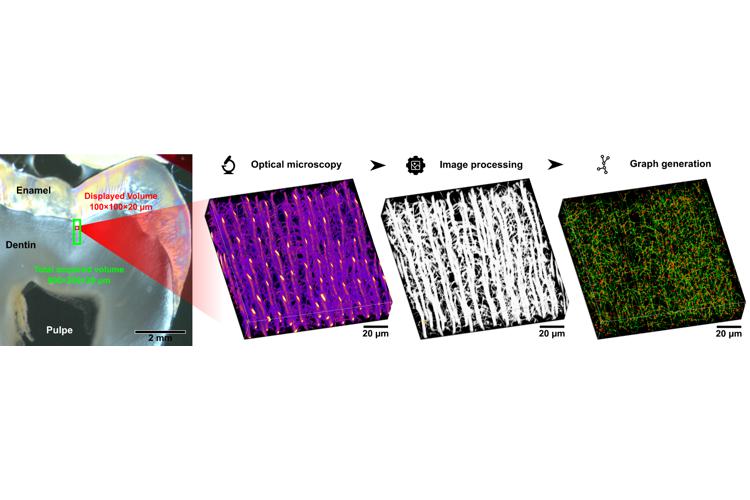- Share
- Share on Facebook
- Share on X
- Share on LinkedIn
Thesis defence
On December 1, 2025

Lucas Chatelain (OPTIMA, LIPhy)
Teeth are complex organs sensitive to external physical perturbations (e.g., thermal and mechanical) under physiological conditions. According to hydrodynamic theory, these stimuli are propagated to the cell bodies of the odontoblasts and nerve endings located in the pulp via fluid flow in dentinal porosity. This porosity is mainly formed by long parallel microscopic tubules running from the pulp to the enamel, but there are also secondary branches forming connections between tubules. These fine sub-micrometric branches are difficult to image over large volumes, and their impact on the interconnections between tubules therefore remains unknown. However, the topology and geometry of dentin porosity determine dentin fluid flow. The mechanosensory function of the tooth could therefore be more complex than currently described in the literature.
Porosity imaged by confocal fluorescence microscopy confirms a high density of branches and interconnections with tubules, which varies depending on the location within the tooth. Modeling porosity as a graph thus allowed demonstrating that dentin porosity forms a highly connected network with topological characteristics distinct from other types of biological physical networks. An in-depth analysis of biases in graph modeling was performed to determine margins of error on graph metrics and predict their evolution according to experimental conditions and image processing. This provides a useful framework to evaluate the statistical relevance of measurements acquired under a broader range of conditions than ours. The comparison of colocalized acquisitions from confocal and two-photon fluorescence microscopy illustrates the richness of interpretation of graph analysis in deciphering complex phenomena. The results obtained on five samples in different anatomical regions confirmed our initial observations. A comparison of graph metrics and histological parameters is also proposed to facilitate transfer to biomedical research. This preliminary work also paves the way for more complex analyses of fluid flow simulations on graphs, or clinical research on pathologies or treatments affecting dentinogenesis.
Date
13:30
Localisation
LIPhy, salle de conférence
- Share
- Share on Facebook
- Share on X
- Share on LinkedIn